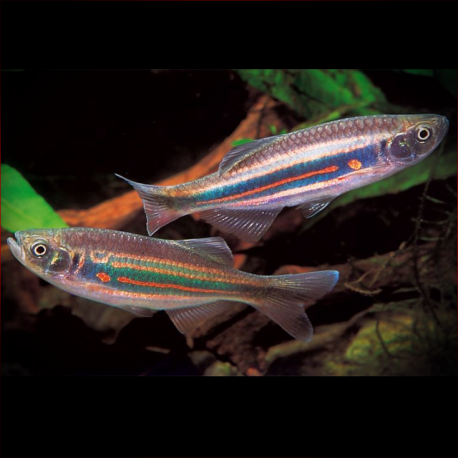More info
Datasheet
| Minimum Tank Size | 270 litres / 71.33 US gallons |
| Maximum Size | 9.0cm / 3.54inches |
| Temperature | 15°C / 59.00°F - 22°C / 71.60°F |
| Hardness | 2.02dgH / 36ppm - 12.05dgH / 215ppm |
| pH | 6.0-8.0 |
General Description
The Devario Assamensis, also known as Danio Assamensis, is a rare species in the aquarium trade, characterized by its deep-bodied form with a P stripe extending to the caudal-fin fork. This fish is a schooling species and should ideally be kept in a group of at least 8-10 specimens for a more effective and natural display. While not aggressive, its constant activity and vigorous feeding behavior may disturb slow-moving or timid tankmates.
Aquarium Setup
The Devario Assamensis thrives in aquariums resembling flowing streams or rivers, with a substrate of rocks, sand, gravel, and driftwood. Hardy aquatic plants like Microsorum or Anubias can be added. Regular water changes, high oxygen levels, and moderate water movement are crucial for their well-being. A tightly fitted cover is necessary due to their jumping tendencies (see table).
Behaviour
This species tends to establish a hierarchy within its group, containing aggression within the school. Males display better colors in the presence of rivals. The fish should be kept with robust, similarly-sized tankmates to avoid stressing slower or timid species.
Feeding and Diet
Devario Assamensis mostly preys on insects and larvae in the wild, translating to an unfussy eater in captivity. Their diet should include a good quality dried product supplemented with live or frozen foods like bloodworms, Daphnia, and Artemia for optimal coloration and health.
Reproduction & Dimorphism
Devario Assamensis are egg-scattering free spawners without parental care. Dimorphism is evident in sexually mature females who are rounder, less colorful, and slightly larger than males. Proper conditioning and a well-planted breeding tank are required to encourage successful spawning and fry survival.
Habitat and Distribution
Native to streams and rivers of Assam, India, this species adapts to both lowland and high-altitude environments with clear, oxygenated waters. They are found in various parts of the Brahmaputra river system, at altitudes ranging from 250m to 1767m, and possibly higher in Bhutan. The fish are versatile in tolerating varying water flow, volume, and temperatures.

